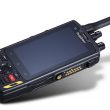Busted by GPS/AVL
After 18 days of tracking the suspect around Spokane, the police located him on an old logging road where he used to hunt.
Between the stolen truck and the containers, the tracking system saved All-Cycle more than $140,000.
A nine-year-old girl was missing in Spokane, WA. The Spokane sheriff’s office suspected that she had been murdered but they couldn’t find her body. They believed the only person who could be responsible for the girl’s disappearance was her father, based on circumstantial evidence against him. He was also the only one at home when the girl disappeared. Unfortunately, the investigators had no evidence to confirm the father as the offender.
During this investigation, the sheriff’s office received three GPS/AVL units on loan for evaluation from the U.S. Army Counterdrug Technology Assessment Center/Technology Transfer Program. The sheriff’s office had requested the equipment to help fight local drug traffic. In return, the sheriff’s office would assess the equipment’s effectiveness for the Army. The equipment included ISR’s Fleettrack, which uses GPS to locate fleet vehicles. It can also be used to target a specific vehicle.
The homicide detective working on the missing-girl case asked Don McCabe, a detective in the sheriff’s drug enforcement unit, if he could borrow a GPS receiver to monitor the father’s whereabouts. Homicide detectives hoped the father would lead them to the girl’s body or at least to some evidence that would further implicate him, or eliminate him, as a suspect.
The Spokane sheriff obtained a search warrant that allowed GPS receivers and location transmitters to be placed on two of the father’s vehicles. Detectives tracked the suspect, using the tracking software installed on a Gateway 350 desktop computer and on a Gateway laptop that was equipped with a cellular data link so that mobile officers could participate. The displays were set to show changes in position every 15 seconds.
After 18 days of tracking the suspect around Spokane, the investigators located him on an old logging road where he used to hunt. It was there they later found the girl’s body buried about 50 feet off the road.
Spokane’s sheriff’s drug enforcement unit had not had an opportunity to use the tracking equipment before Homicide had borrowed it. However, observing Homicide’s successful application, Det. McCabe said it was “Definitely worthwhile to use again in future crime cases.”
GPS/AVL properties
GPS was developed as a worldwide navigation and positioning facility for military and civilian use. It uses satellites that orbit the Earth and constantly transmit their precise time and position in space. After determining its relative position to several satellites, a GPS receiver can determine the exact location of its host vehicle using triangulation techniques.
ISR has been installing GPS/AVL systems for government and commercial customers since 1986. Some of its customers include the U.S. Army, the FBI, the Mayo Clinic, and the General Motors Proving Grounds. ISR developed the Fleettrack system in 1995. The system’s features are upgradable to allow more receivers to be added and tracked as fleet needs grow. As many units as needed can be managed. The standard configuration allows users to track vehicles in real time or to play back a record log at a later time. Analysis of the playback can be used to schedule fleet operations. The system continuously records real-time data about a truck’s operations, including speed and location. It notifies dispatchers when a truck deviates from a planned route, leaves a specific zone or is standing still for more than 15 minutes (or any other pre-set time).
A new version of Fleettrack offers automatic switching of data transmissions from cellular digital packet data to an analog cellular network. This improvement to the hardware and software can cut operation costs because the system discriminates when to switch from CDPD to more expensive analog coverage channels. An example would be if a vehicle moves out of range. CDPD has been deployed in more than 70 major metropolitan areas in recent years, but as vehicles leave these densely covered urban areas, they move out of CDPD’s range. When that happens, fleet managers must rely on an analog cellular network, which, on average, can cost between 10 to 20 times more than CDPD for position updates.
The tracking software now offers more options for a user to display maps, to conduct two-way messaging with radio units, to monitor vehicles for safety and to generate reports. By clicking on an icon, fleet managers can communicate with a specific vehicle, control location sensors implanted in the vehicle, and load or scan vector maps into the system. An entire fleet can be tracked simultaneously. Managers can also remotely monitor data inputs such as speed, refrigeration temperature and door locks status in real time.
For driver and property protection during emergencies, the tracking system includes remote in-vehicle panic buttons. Because of its compatibility with other software applications, the system also allows reports to be generated. The tracking system can be run from a notebook computer in a mobile dispatch unit or from a PC in a central dispatch facility. The system is compatible with most leading radio, cellular and satellite sensors.
Loss recovery and prevention
Fighting crime is a dirty business, but one sanitation company used GPS/AVL to clean up a criminal’s act.
All-Cycle Sanitation of Woodstock, GA, had initially installed a Fleettrack system to locate its trucks at the beginning of a workday. Drivers often took the trucks home at night to get an early start on collection routes that began before daybreak. The company had no idea it would one day help them catch a thief.
One morning last year Anthony Grutadaurio, co-owner of All-Cycle Sanitation, noticed on his computer monitor that one of his trucks was moving when it should have been parked. Grutadaurio called his dispatcher to find out if the truck had been ordered onto the road, but it had not. He then checked the travel data report that the tracking system compiles. The truck’s recent activity showed that it had been moving during off hours between a sanitation facility where All-Cycle dumps its client’s refuse and a non-customer construction site.
Grutadaurio’s partner, Barry Skolnick, got in a car and tailed the truck, using the tracking system as a guide. Eventually he caught up with the truck and followed it until the police arrived to arrest the driver on a theft charge. The excitement wasn’t over yet.
The plot thickened when an irate Woodstock resident called to complain that an All-Cycle truck had dumped a container of refuse on his street. The refuse came from a customer’s construction site, from which All-Cycle collected loads to deposit in a landfill.
After reviewing historical data from the tracking system, it was determined that the same person who stole the truck also dumped the refuse. Because all deposits at the landfill are ticketed back to All-Cycle, the company deduced that the driver was being bribed by the non-customer contractor to dump its waste at the landfill. To avoid detection and additional billing, the driver just dumped the legitimate customer’s refuse on the streets.
Using recorded data from the tracking system, All-Cycle pinpointed the non-customer’s location. At that site, All-Cycle discovered six of its own new 40-yard capacity containers — filled with debris. Because empty containers are warehoused at the landfill, the truck driver had easy access to the units. These six containers, worth $25,000, might not have been found without the tracking playback. Between the stolen truck and the containers, the tracking system saved All-Cycle more than $140,000.
“The police were impressed with how well the ISR Fleettrack really works,” said Skolnick. “Without ISR Fleettrack, we would have never uncovered the scam.”
Taylor is associate editor. Her email address is [email protected].












